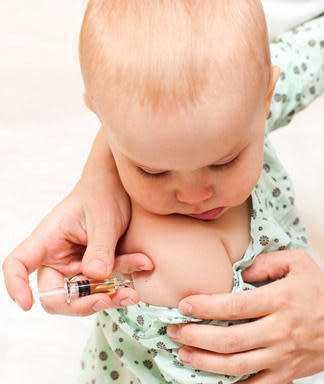4 Things You Didn’t Know About Vaccines
By Barbara Brody

As medicine advances, so does the number of needle jabs: A baby born today may get 50 shots (including boosters) before her 18th birthday, compared to 11 for a child born in 1983. This means kids are being protected against a greater number of potentially deadly diseases. (Before vaccines, 3,000 U.S. kids each year died just from measles, and 10,000 annually were paralyzed by polio!) But even though there's plenty of evidence that vaccines are safe, some parents are still nervous. Here, four facts to help ease your mind.
1. Your child may not have to get so many vaccines on the same day. The American Academy of Pediatrics (AAP) schedule has kids getting as many as seven vaccines during one checkup. Most doctors say this is perfectly safe, but a few (including pediatrician Robert Sears, MD) say giving so many at once may increase the risk of side effects. If you'd prefer to space out the shots, talk to your doctor. Alanna Levine, MD, an AAP spokeswoman, says she doesn't mind giving only one shot per visit as long as a parent is willing to bring her baby back every other week to ensure that she sticks to the AAP schedule. Others may let you delay one or two specific vaccines for a few months, and a much smaller group, including Dr. Sears, will deviate from the AAP schedule dramatically.
2. Thimerosal is no longer found in most vaccines. For years, parents worried that thimerosal-a preservative made with mercury-might trigger autism. Numerous studies have found no such link, but the scrutiny led public health agencies to recommend its removal from childhood vaccines in 2001, explains Mary Anne Jackson, MD, chief of infectious diseases at Children's Mercy Hospital in Kansas City. The exception: Trace amounts are still in some flu shots. Most experts say this is safe-in fact, autism rates have increased since thimerosal was taken out of most vaccines-but if you'd rather avoid it, ask your doctor if she can get a version that doesn't contain it.
3. Reactions are pretty common. One in four children who get the DTaP shot (diphtheria, tetanus and acellular pertussis), for example, will have a mild reaction like fever, redness or swelling, or soreness or tenderness at the injection site. (Learn more at CDC.gov/Vaccines/ Vac-Gen/Side-Effects.htm.) Icing the spot and giving ibuprofen usually helps. But if a reaction seems serious (your child's arm swells up like a softball or he runs a high fever), call your doctor.
Everything you need to know about treating a child's fever.
4. Shots don't have to hurt so much. Distraction goes a long way, says Dr. Jackson, who suggests kids pretend they're blowing out a birthday candle while counting 1, 2, 3. You can also use Buzzy-a plastic device shaped like a bumblebee-that you press on your child's skin next to the injection site, says Dianna Tolen, MD, a pediatrician who uses it in her practice in Canfield, Ohio ($34.95; Needle-Pain-Management.com). It distracts by vibrating and perhaps confusing the nervous system so it doesn't focus on the pain.
Photo: © Shutterstock
Original article appeared on WomansDay.com.
Related Articles on WomansDay.com:
Essential Back-to-School Medical Checkups
14 Ways to Get Your Kids to Eat Better
Do You Know When to Go to the ER?
